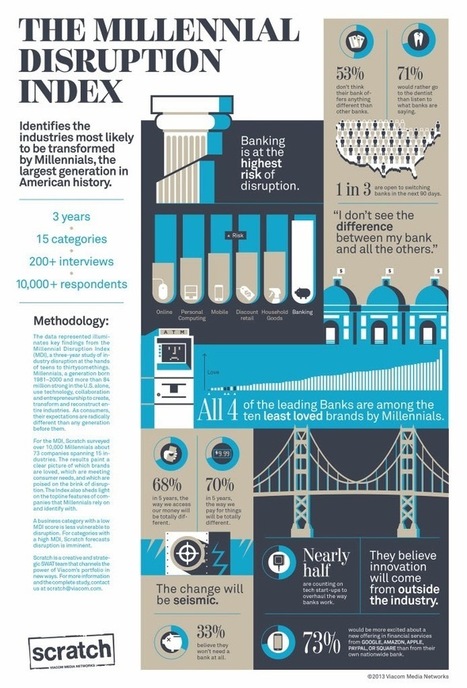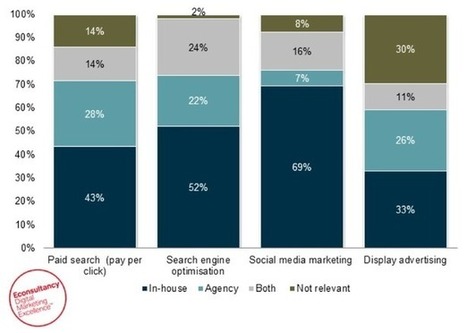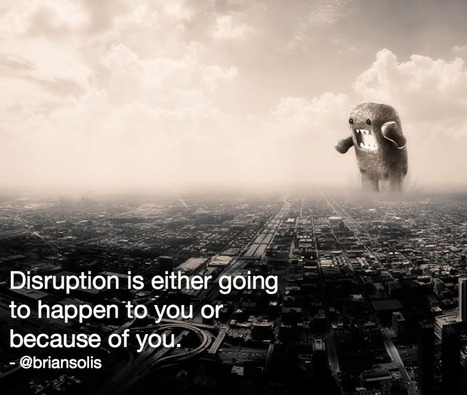 Your new post is loading...
 Your new post is loading...
We’ve entered the most profound era of change for financial services companies since the 1970s brought us index mutual funds, discount brokers and ATMs. No firm is immune from the coming disruption and every company must have a strategy to harness the powerful advantages of the new financial technology (“fintech”) revolution. The battle already underway will create surprising winners and stunned losers among some of the most powerful names in the financial world: The most contentious conflicts (and partnerships) will be between startups that are completely reengineering decades-old practices, traditional power players who are furiously trying to adapt with their own innovations, and total disruption of established technology & processes....
Yet, two decades after Christensen published his original article, the idea of disruptive innovation has achieved almost meme-like status in Silicon Valley — and lost much of its original meaning in the process. Today, “disruption” is used to justify any and every innovation coming out of the tech sector.
Dismayed by this misuse of his work, Christensen recently wrote a reply to his critics, titled “What Is Disruptive Innovation?” Given the overuse that “disruption” has endured over the last few years, his article (co-authored by Michael E. Raynor and Rory McDonald) was a needed reset around how the theory of disruptive innovation should be applied — and where it shouldn’t be....
5miles, the Dallas and Beijing-based challenger to Wallapop and Craiglist has secured $30 million in new investment as it celebrates its first year in business this month.
The 1-year-old 5miles mobile marketplace app has managed to attract more than 5 million users (averaging 30,000 downloads a day) and is continuously working towards becoming a major player in the local online classified advertising business that’s been long dominated by Craiglist.
Its list of investors now includes IDG, Morningside, Blue Lake, and SIG-China (part of the Susquehanna Investment Group). In addition, individuals who have worked with or have ties with e-commerce giants like eBay and Alibaba have also invested in the app....
Digital technology has proven to be game-changer that most established parties don’t know how to deal with. Confronted by digitally fluent competitors, market leaders underestimate the degree to which they must adapt, and are left behind in a rapidly changing market.
How can established brands maintain or secure a competitive advantage alongside disruptive start-ups which seem to be dominating the digital landscape? This article puts forward the idea that what sets a company apart in the digital age cannot be found between a company’s walls. In this day and age, a successful brands establishes its competitive advantage by being structurally present in the life of the consumer....
A three-year study from Scratch, an in-house unit of Viacom, found that a third of millennials believed they won't need a bank in the future. These millennials, defined as those between ages 18 to 33, also ranked the top four banks in the "ten least loved brands" and would rather go to the dentist than to their bank.Is this surprising?
This segment of the population has grown up in an era that saw trust in banking erode due to the financial crisis and a near stagnant economy. This is also a period when new technology has enabled firms like Simple, Moven, Square and PayPal to be more relevant with a generation that would rather handle finances on their phone than in a branch.
Here are some of the findings from the Millennial Disruption Index:
Healthcare is a $2.8 trillion industry, and it’s currently in a state of chaos. The Affordable Care Act is reshaping the sector. Patients are more mobile than ever, and turnover in the C-suite is skyrocketing, with the average lifespan of a healthcare CEO lasting just three and a half years.
Many of these new CEOs have no healthcare background, making the impact of the turnover even more dramatic. And when new CEOs take the helm, there’s an 87 percent chance they’ll replace the company’s current CMO.
With a shifting landscape comes a restructuring of paradigms, particularly for healthcare marketing. How can we not only survive these changes, but seize the opportunities they present?...
To be successful in the new multichannel and digital age businesses have to adopt an integrated approach to marketing.
And as companies seek to join up what have often been siloed activities, agencies are moving towards a fuller service offering to cater for the increased demand.
Data included in our new UK Search Engine Marketing Benchmark Report 2013 shows that more than half of agencies (52%) now offer a ‘full range of digital marketing services’, an increase from 45% in 2012 and 42% in 2011.
In comparison just 12% of agencies specialise in SEO while 7% focused exclusively on paid search. A further 10% of agencies carry out both SEO and paid search....
What if tomorrow you woke up and found out that you suddenly had to compete against a customer experience giant – the likes of Southwest, Apple, or the Ritz Carlton. What if one of these well known and deeply loved brands swooped into your marketplace? Would your customers stay? Or would they happily test out the new entrant? Would they be delighted to have options instead of being forced to do business with you and your usual group of hardly differentiated competitors? Could you compete against a customer experience giant?
This is exactly what happened to the B2B supply industry when Amazon joined the industrial distribution market last year. Product categories covered include: lab equipment, occupational health and safety, janitorial and sanitation, office, power and hand tools, and the list goes on. In true Amazon fashion, orders over $50 or more receive two day shipping. In addition, they offer free 365 day returns and financing through their corporate lines of credit. Overnight, B2B suppliers were faced with competing against a company with a notoriously delightful customer experience.
Not surprisingly, there’s been a healthy amount of debate around how willing customers will be to trade in personal service for faceless procurement. But new research by Acquity Group shows that buyers have been quite willing to at least give Amazon Supply a try. Now, to make matters worse, Google is joining Amazon in the fight for the B2B buyer as it rolls out services to the electrical and electronics industries....
The rise of spontaneous social ads means the end of the ad campaign as we know it. fascinating thing happened at the Super Bowl this year. Typically, Super Bowl advertisers meticulously plan every aspect of their presence months in advance of the big game. But this time, Coca-Cola, Audi, and Oreo didn't just limit themselves to pre-packaged creative — they also had in place rapid response teams that adapted to events as they happened. So when the rest of America was reacting to the power outage in the stadium, the brands were, too — appropriately and in their own brand voice. Recently, the Wharton Future of Advertising Program asked more than 175 industry leaders to describe their vision of what advertising would be like in the year 2020. Based on our analysis of the responses to the 2020 Project, the Super Bowl case isn't just a once-a-year stunt — it's a preview of a model that will scale and become a foundational characteristic of major brand advertising. The industry experts had a varied take, but a remarkably consistent theme emerged: the rigid campaign-based model of advertising, perfected over decades of one-way mass media, is headed for extinction....
|
Rather than look at just one year ahead, I organized my research against a two-year horizon and then added an analytical layer of what each trend meant and why each was important. But that still wasn’t enough. Nothing moves in calendar cycles except for taxes, birthdays, anniversaries, earning reports, etc.
So, this year, I added one year to the event horizon… Introducing the “26 Disruptive Technology Trends for 2016 – 2018.”
In this report, we’ll explore some of the disruptive trends that are affecting pretty much everything over the next few years-at least those that I’m following. It’s not just tech, though. The report is organized by socioeconomic and technological impact....
Global delivery company DHL started its business by offering free plane tickets to people on the street. For the trouble of giving up their baggage allowances, passengers were handed a free round-trip plane ticket to Hawaii.
Founded as a courier service in 1969, DHL used the spare capacity in travelers’ luggage to transport high-value documents. To understand why it made sense for DHL to provide free tickets to travelers, it helps to understand the massive changes entailed by the containerization of ocean cargo in the 1960s.
Your plan is to be the disruptor, not be disrupted. Futurist Ade McCormack share five ways to do business to help you move from the industrial era into the digital era.There are times in history when economic sensibility has headed out the window. Do you remember the dotcom bubble? Concepts such as value, supply and demand, and profitability were temporarily considered old fashioned....
The Internet of Things, mobile technology, and omnichannel marketing stand among the many innovations transforming the customer experience. Marketing has become a fundamental driver of IT purchasing. In fact, Gartner analyst Laura McLellan predicts that by 2017, CMOs will spend more on IT than their counterpart CIOs.
While marketing optimization technologies create numerous opportunities for enterprises, there’s a complexity in identifying which ones will work best and deciding how to blend them with marketers’ current approaches. Whether you work for a startup or a large enterprise, creating a strategy for assessing new tools and solutions should be every marketer’s first step. It’s easy to get distracted by the promises of the latest platform, technology, or tool but marketers need to stay focused on their customers and business goals.
Here are three things marketers should avoid when implementing a new marketing tool or technology....
Moving into 2014, there are companies and emerging sectors that we as marketers should keep our eyes on. While some already boast tens or even hundreds of billion-dollar market caps, they continue to innovate in unexpected ways.
Conversely, where others are unproven, they still warrant attention for the uncharted territories they ambitiously explore. All, however, are bold market disruptors paving roads for marketers and agencies to follow and learn from as we look to bring some of 2014’s promises to life....
A panel of experts debate what the most disruptive technology will be for broadcasting...It has impacted the way viewers consume content – not only how, but where and when they watch shows or videos. Due to the proliferation of devices, viewers can access content at any time, at any location, on the device of their choosing, so eyeballs are rarely giving their full attention to traditional platforms like TV.
With traffic to sites such as blinkx, YouTube and Facebook growing every day, and video shared more than any other medium by consumers, it’s clear to see who’s stealing the limelight. What’s more, online video provides consumers with more choice and more flexibility. The web hosts a variety of content that traditional broadcasters could never compete with, be it snackable three-minute videos on the bus ride home or exclusive, online shows streamed straight to your iPad....
In our social media-infused world, traditional marketing logic just doesn't work.Traditional marketing — including advertising, public relations, branding and corporate communications — is dead. Many people in traditional marketing roles and organizations may not realize they're operating within a dead paradigm. But they are. The evidence is clear.
First, buyers are no longer paying much attention. Several studies have confirmed that in the "buyer's decision journey," traditional marketing communications just aren't relevant. Buyers are checking out product and service information in their own way, often through the Internet, and often from sources outside the firm such as word-of-mouth or customer reviews.Second, CEOs have lost all patience.
In a devastating 2011 study of 600 CEOs and decision makers by the London-based Fournaise Marketing Group, 73% of them said that CMOs lack business credibility and the ability to generate sufficient business growth, 72% are tired of being asked for money without explaining how it will generate increased business, and 77% have had it with all the talk about brand equity that can't be linked to actual firm equity or any other recognized financial metric...
"Technological revolutions happen in two main phases: the installation phase and the deployment phase," observes Angel of the Year and new Andreessen Horowitz GP Chris Dixon, who says that the turning point between those phases for the Age of Information is…now.
Clay Christensen literally wrote the book on disruption, so it’s worth paying attention to him when he talks about where the disruption fueled by the web is going to strike next. The Harvard business professor and author of The Innovator’s Dilemma spoke to Jeff Howe — the Wired writer who coined the term “crowdsourcing” — and had some interesting things to say about where disruption is occurring now and where it is likely to strike next. At one point, Howe asks Christensen to name some industries that are “either in a state of disruptive crisis or will be soon,” and the professor says: “Journalism, certainly, and publishing broadly. Anything supported by advertising. That all of this is being disrupted is now beyond question. And then I think higher education is just on the edge of the crevasse. Generally, universities are doing very well financially, so they don’t feel from the data that their world is going to collapse. But I think even five years from now these enterprises are going to be in real trouble.”...
|



 Your new post is loading...
Your new post is loading...



































Disruption is the new future reality for the financial technology sector.